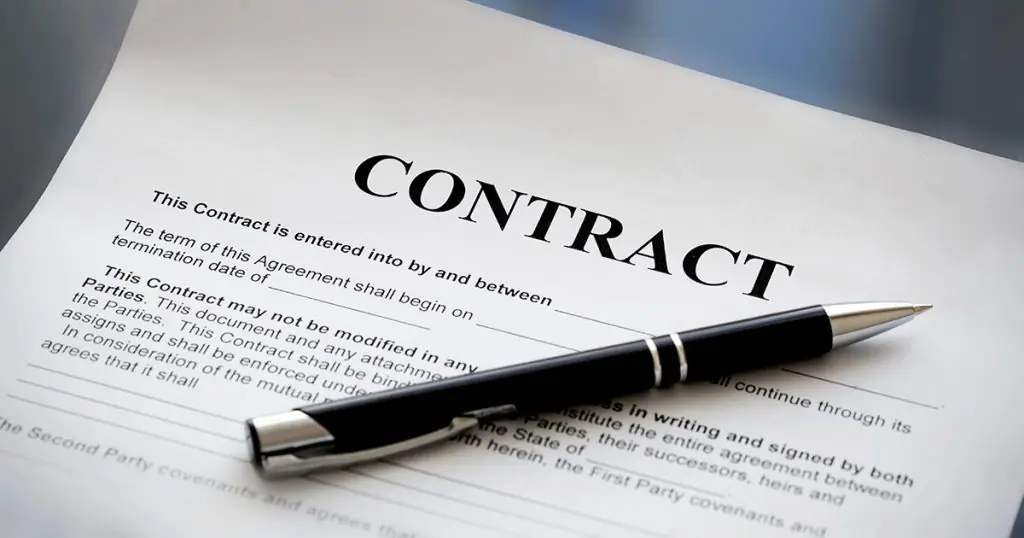In previous posts, we discussed various types of contracts based on the nature of transaction, mode of project delivery, and compensation method.
The next step in the journey is learning how to draft a good contract — one that’s simple, error-free, and easy to execute.
In this post, we’ll explore six important contract drafting rules that help create a dispute-free agreement. These principles are essential for anyone involved in contract management, procurement, or legal drafting.
Contract Drafting: A Highly Specialized Skill
Contract drafting is a specialized skill that requires experience, maturity, and sound judgment. A good contract writer must have:
- A solid understanding of industry practices
- In-depth knowledge of contract and procurement laws
- A balanced, practical mindset
An extreme or casual approach in contract writing can make an agreement void, unenforceable, or open to litigation. Poorly drafted contracts often lead to confusion, misinterpretation, and unnecessary disputes. The result is wasted time, money, and effort.
Even when matters don’t escalate to legal disputes, unclear contracts create misunderstanding and endless correspondence — defeating the very purpose of having a written agreement.
Contracts Should Be Easy to Understand and Interpret
The ultimate goal of contract drafting is clarity. Both parties should read the contract and interpret every clause in the same way.
To achieve this, each contract clause should be written in a way that avoids ambiguity, duplication, and contradiction.
Following certain contract drafting techniques helps achieve this clarity. These are known as Contract Drafting Rules, and six of them are discussed below:
- Use appropriate language
- Avoid contradiction
- Avoid duplication
- Use references and cross-references
- Write mutually explanatory and complementary clauses
- Maintain uniformity and consistency
Let’s go through each one in detail.
1. Use Appropriate Language
This is one of the most important contract drafting rules because contracts are interpreted entirely through language. For smooth execution, both parties must draw the same meaning from every provision.
While drafting a contract:
- Use language that’s easy to understand and interpret
- Prefer simple, professional words used in day-to-day business communication
- Avoid complex vocabulary, legal jargon, or harsh phrasing
- Eliminate emotional or persuasive adjectives — a contract is meant for clarity, not rhetoric
In legal drafting, clarity is always more powerful than sophistication. Simple, neutral wording prevents misinterpretation and supports seamless execution.
2. Avoid Contradiction
A contradiction occurs when two or more provisions conflict with each other. For example, one clause may state that the time for completion is 12 months, while another mentions 9 months.
Such inconsistencies cause confusion and can easily turn into disputes, as each party refers to the version that best supports its argument.
A typical procurement contract includes several documents, such as:
- Contract Agreement
- Letter of Acceptance
- Particular Conditions of Contract
- General Conditions of Contract
- Technical Specifications
- Data Sheets and Drawings
- General Technical Requirements
Each of these documents forms an integral part of the contract and contains clauses defining the rights and obligations of the parties. Therefore, it’s critical to ensure there’s no contradiction — within the same document or across related documents.
Contradictions often arise because different departments review the contract separately. Each reviewer edits clauses related to their scope but may overlook corresponding changes needed elsewhere. This leads to inconsistent versions and conflicting clauses.
To avoid this, contract writers must adopt a holistic drafting approach, reviewing all documents collectively before finalization.
3. Avoid Duplication
Duplication refers to repeating similar provisions multiple times, either in the same document or across different contract documents.
It’s a common problem in large procurement contracts. Often, the contract department prepares a draft, which is then reviewed by a cross-functional team. Each reviewer modifies clauses related to their domain but doesn’t always check if similar provisions already exist elsewhere.
This repetition may look harmless but can lead to ambiguity and disputes, especially when the repeated provisions differ slightly in wording. Each party may interpret the clauses differently and use them selectively to support their position.
To prevent this, the contract writer must ensure there’s no unnecessary repetition of any provision. If a clause or requirement is already defined elsewhere, simply refer to it — don’t restate it.
This minimizes confusion and keeps the contract structure clean, organized, and easy to interpret.
4. Use References and Cross-References
A well-drafted contract isn’t a random collection of independent statements. It’s a structured set of interconnected clauses that depend on each other.
A good contract writing technique is to link related clauses using references and cross-references instead of repeating them.
For example:
“The Contractor shall comply with the safety requirements mentioned in Clause 7.3.”
This simple method avoids duplication, reduces inconsistency, and keeps the contract concise. It also makes updates easier — when one clause changes, every related clause remains accurate through the reference.
Using cross-references demonstrates professionalism and helps ensure that the contract document reads as one unified, logically connected agreement.
5. Write Mutually Explanatory & Complementary Clauses
Each clause in a contract serves a specific purpose. Likewise, each contract document focuses on a different aspect of the transaction.
For instance:
- The Conditions of Contract cover commercial and legal aspects
- The Technical Specifications outline operational and functional requirements
- The Drawings provide the technical blueprints of the final deliverable
Together, these documents should explain and complement one another. Each fills the gaps left by the others, ensuring that the overall agreement is complete and self-explanatory.
When clauses are mutually supportive, they prevent misinterpretation and make the contract easier to administer. The ultimate goal is to create a document where all parts work together — forming a single, comprehensive understanding between the parties.
6. Maintain Uniformity and Consistency
This is one of the golden rules of contract drafting and contract management.
Define all key terms clearly at the start, then use those same terms consistently throughout the contract. Consistent terminology ensures clarity and eliminates confusion about meaning or intent.
In practice, different teams handle contract formation and contract administration, so maintaining uniform language helps everyone interpret the document correctly. It also helps third parties — such as auditors, arbitrators, or courts — quickly understand the context.
For example:
- If the term “Program” is defined as Project Schedule, use “Program” everywhere. Don’t alternate with Schedule, Completion Schedule, or Execution Schedule.
- If “Employer” refers to the project owner, avoid switching to Owner or Purchaser elsewhere.
Uniformity and consistency make the contract look professional, readable, and legally sound.
Top 10 FAQs on Contract Drafting and Contract Law
1. What are the 6 rules of contract drafting?
The six key rules of contract drafting are:
- Use appropriate language
- Avoid contradiction
- Avoid duplication
- Use references and cross-references
- Write mutually explanatory and complementary clauses
- Maintain uniformity and consistency
These principles ensure that a contract is clear, accurate, and free from ambiguity or disputes.
2. What are the 6 rules of contract law?
The six fundamental rules of contract law generally refer to the essential elements required for a contract to be valid:
- Offer and acceptance
- Intention to create legal relations
- Lawful consideration
- Capacity of parties to contract
- Free consent
- Lawful object
If any of these elements are missing, the contract may be considered void or unenforceable under law.
3. What are the 5 C’s of contract law?
The “5 C’s of contract law” highlight key factors that make a contract clear and effective:
- Clarity – Terms must be specific and understandable.
- Completeness – All important obligations should be included.
- Consistency – No contradictions or conflicting clauses.
- Compliance – The contract must follow all relevant laws.
- Care – The document should be reviewed thoroughly before signing.
These principles help in minimizing risk and avoiding disputes.
4. What are the 6 elements of a contract?
The six essential elements that form a valid contract are:
- Offer – One party proposes an agreement.
- Acceptance – The other party agrees to the proposal.
- Consideration – Something of value is exchanged.
- Intention to create legal relations – Both parties intend for the agreement to be legally binding.
- Capacity – Both parties are competent to contract.
- Legality – The purpose of the contract must be lawful.
Without these elements, a contract may not hold up in court.
5. What are the six stages of contract management?
The six key stages of contract management are:
- Preparation and Planning
- Contract Drafting and Negotiation
- Approval and Execution
- Performance and Monitoring
- Amendments and Compliance Review
- Closure and Renewal
Following these stages ensures smooth execution, risk control, and effective performance tracking.
6. What is the validity of a contract?
The validity of a contract depends on whether it fulfills all legal requirements such as free consent, lawful consideration, competence of parties, and a legal purpose.
In most cases, a contract remains valid until:
- The obligations are fulfilled,
- It expires by term, or
- It’s terminated by mutual consent or breach.
A contract without essential elements (like consent or legality) is considered void or voidable.
7. Why is contract drafting important?
Contract drafting is crucial because it defines the rights, responsibilities, and obligations of all parties. A well-drafted contract prevents ambiguity, ensures smooth execution, and reduces the likelihood of disputes or litigation.
8. What is the difference between contract drafting and contract management?
Contract drafting involves creating the contract document — writing terms, conditions, and clauses.
Contract management begins after signing, focusing on performance, compliance, amendments, and renewals.
Both are essential for a successful business relationship.
9. What are common mistakes in contract drafting?
Some common mistakes include:
- Using vague or conflicting language
- Repeating provisions unnecessarily
- Missing cross-references
- Failing to define key terms
- Ignoring jurisdiction or dispute resolution clauses
Avoiding these ensures clarity and enforceability.
10. What are the basic principles of good contract drafting?
Good contract drafting is guided by principles like clarity, precision, consistency, balance, and completeness. A well-drafted contract should be easy to read, legally sound, and reflect a fair understanding between both parties.
Conclusion
These six contract drafting rules form the backbone of a clear, reliable, and enforceable contract:
- Use Appropriate Language
- Avoid Contradiction
- Avoid Duplication
- Use References and Cross-References
- Write Mutually Explanatory & Complementary Clauses
- Maintain Uniformity and Consistency
By following these best practices in contract writing and management, you can create documents that are easy to understand, free from ambiguity, and less prone to disputes.


